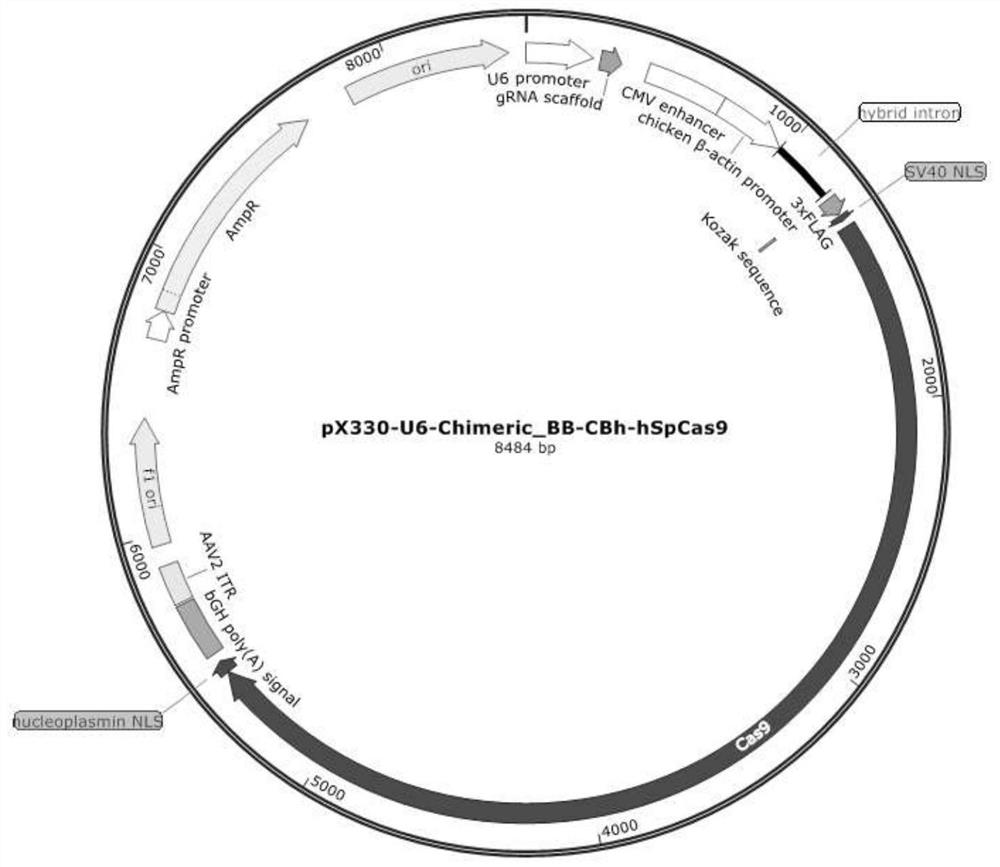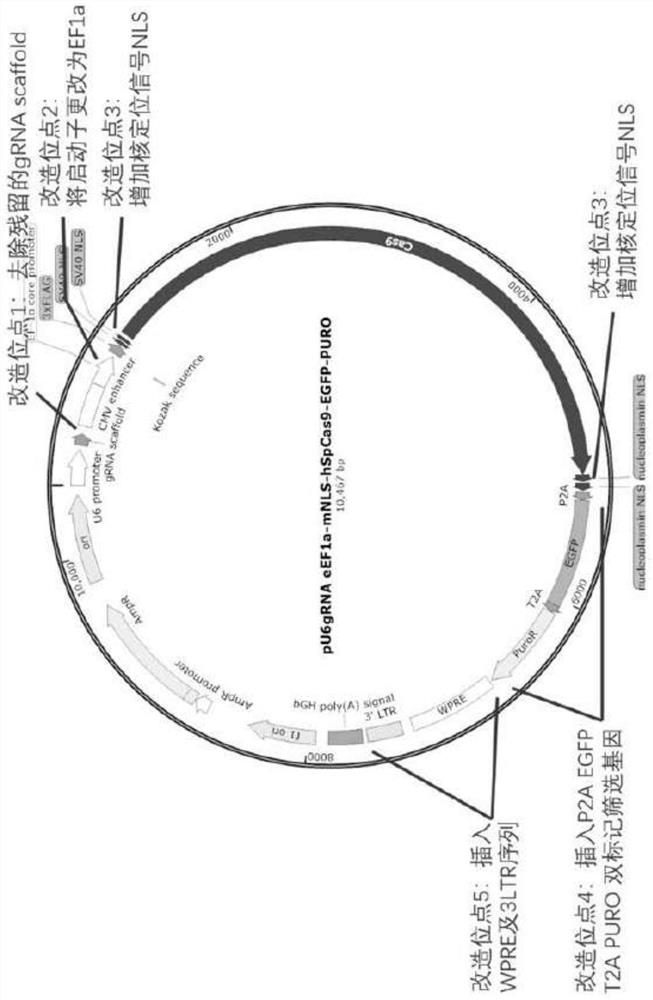OPG gene editing system for constructing osteoporosis cloned porcine nuclear donor cell line and application of OPG gene editing system
An osteoporosis and gene editing technology, applied in the field of gene editing, can solve the problems of inapplicability and low probability of homozygous mutation progeny, achieve good applicability, improve nuclear localization ability, and increase the number of nuclear localization signals. Effect
- Summary
- Abstract
- Description
- Claims
- Application Information
AI Technical Summary
Problems solved by technology
Method used
Image
Examples
Embodiment 1
[0043] Embodiment 1, the preparation of plasmid
[0044] 1.1 Preparation of plasmid pU6gRNA eEF1a-mNLS-hSpCas9-EGFP-PURO (plasmid pKG-GE3 for short)
[0045] The sequence of the original plasmid pX330-U6-Chimeric_BB-CBh-hSpCas9 (abbreviated as plasmid pX330) is shown in SEQ ID NO:1. The schematic diagram of the structure of plasmid pX330 is shown in figure 1 . In SEQ ID NO: 1, the 440-725 nucleotides form the CMV enhancer, the 727-1208 nucleotides form the chickenβ-actin promoter, and the 1304-1324 nucleotides encode the SV40 nuclear localization signal (NLS ), the 1325-5449th nucleotide encodes the Cas9 protein, and the 5450-5497th nucleotide encodes the nucleoplasmin nuclear localization signal (NLS).
[0046] Plasmid pU6gRNA eEF1a-mNLS-hSpCas9-EGFP-PURO, referred to as plasmid pKG-GE3, the nucleotide is shown in SEQ ID NO:2. Compared with the plasmid pX330, the plasmid pKG-GE3 has been mainly modified as follows: ① Remove the residual gRNA backbone sequence (GTTTTAGGCTA...
Embodiment 2
[0059] Example 2 Plasmid Proportion Optimization and Effect Comparison of Plasmid pX330 and Plasmid pKG-GE3
[0060] 2.1 Target gRNA design and construction
[0061] 2.1.1 Using Benchling to design target gRNA for RAG1 gene
[0062] RAG1-g4: AGTTATGGCAGAACTCAGTG (SEQ ID NO. 9)
[0063] Synthesize complementary DNA oligos targeting the above RAG1 gene target as follows:
[0064] RAG1-gRNA4S: caccgAGTTATGGCAGAACTCAGTG (SEQ ID NO.10)
[0065] RAG1-gRNA4A: aaacCACTGAGTTCTGCCATAACTc (SEQ ID NO.11)
[0066] Both RAG1-gRNA4S and RAG1-gRNA4A are single-stranded DNA molecules.
[0067] 2.1.2 Primers designed to amplify and detect fragments containing the RAG1 gRNA target
[0068] RAG1-nF126: CCCCATCCAAAGTTTTTAAAGGA (SEQ ID NO. 12)
[0069] RAG1-nR525: TGTGGCAGATGTCACAGTTTAGG (SEQ ID NO. 13)
[0070] 2.1.3 The method of cloning the gRNA sequence into the pKG-U6gRNA backbone vector
[0071] 1) Digest 1ug pKG-U6gRNA plasmid with restriction endonuclease BbsI;
[0072] 2) run the ...
Embodiment 3
[0119] Example 3 OPG gene screening for efficient sgRNA target 1
[0120] 3.1 Genomic DNA extraction
[0121] 18 pigs (male A, B, C, D, E, F, G, H female 1, 2, 3, 4, 5) were respectively performed using Vazyme's FastPure Cell / Tissue DNA Isolation Mini Kit (VazymeCat.DC102-01). , 6, 7, 8, 9, 10) Genomic DNA from ear tissue was extracted by column, quantified using NanoDrop, and stored at -20°C for future use.
[0122] 3.2 Conservation analysis of predetermined targets of OPG gene knockout and adjacent genome sequences
[0123] 3.2.1 Gene information of porcine OPG
[0124]Encodes osteoprotegerin protein, also known as TNF receptor superfamily member 11b (TNFRSF11B); located on chromosome 4; GeneID is 100049688, Sus scrofa. The amino acid sequence encoded by the porcine OPG gene is shown in SEQ ID NO.15. Existing research results have shown that OPG plays a central role in the regulation of osteoclast differentiation and activity. In the porcine genomic DNA, the OPG gene has...
PUM
 Login to View More
Login to View More Abstract
Description
Claims
Application Information
 Login to View More
Login to View More - R&D
- Intellectual Property
- Life Sciences
- Materials
- Tech Scout
- Unparalleled Data Quality
- Higher Quality Content
- 60% Fewer Hallucinations
Browse by: Latest US Patents, China's latest patents, Technical Efficacy Thesaurus, Application Domain, Technology Topic, Popular Technical Reports.
© 2025 PatSnap. All rights reserved.Legal|Privacy policy|Modern Slavery Act Transparency Statement|Sitemap|About US| Contact US: help@patsnap.com



